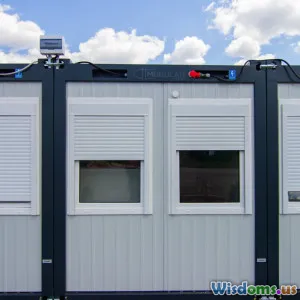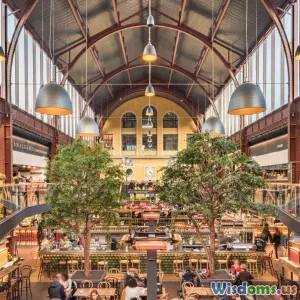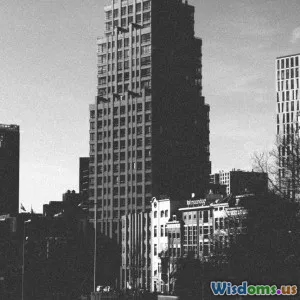
Is Modular Construction the Answer to Rapid Urbanization
7 min read Explore how modular construction addresses the challenges of rapid urbanization with speed, sustainability, and design innovations. (0 Reviews)
Is Modular Construction the Answer to Rapid Urbanization?
Urban spaces around the world are expanding faster than ever before. According to the United Nations, by 2050, nearly 68% of the global population will reside in cities, intensifying the strain on housing, infrastructure, and sustainability. This rapid urbanization calls for revolutionary approaches in architecture and urban design. Modular construction, a method involving prefabricated, factory-built modules assembled onsite, has surged as a potential game-changer. Could this contemporary building method provide the agile, scalable solutions that urban planners and developers desperately need? Let’s unpack the promise and practicalities behind modular construction amid the rise of megacities.
Understanding Modular Construction: A Primer
Unlike traditional construction where every building component is constructed onsite sequentially, modular construction fabricates building sections—complete with plumbing, wiring, and finishes—in controlled factory settings. These modules are transported to the location and assembled like building blocks.
Key advantages include faster delivery times, consistent quality control, and reduced waste. Notably, firms like Katerra and Rocket Homes have propelled modular construction from niche to mainstream, supported by innovations in logistics and digital design.
The Urbanization Challenge: Why Speed and Efficiency Matter
As cities swell, the immediate demand is for housing, infrastructure, and commercial spaces, often within tight timeframes and budgets. Consider Mumbai, India, where around 30 million people crowd into 603 square kilometers—pressure on urban housing is relentless. Traditional construction struggles to keep pace due to resource limitations,the unpredictability of onsite labor, and environmental impacts.
Here, the speed of modular methods can reduce construction time by up to 50%, as found in an empirical study by the Modular Building Institute (MBI). This significant time reduction translates into faster occupancy, relieving housing shortages swiftly and economically.
Sustainability Factor: Modular Construction’s Environmental Footprint
Urbanization brings environmental concerns, such as excessive waste and CO2 emissions. Modular construction addresses these directly. Factory production enables precise resource management, resulting in up to 90% less material waste compared to conventional methods. For example, Cleveland Clinic Abu Dhabi successfully implemented modular techniques, reducing onsite waste drastically while maintaining highest health facility standards.
Additionally, less onsite construction time means lower noise pollution and diminished disruption to urban life. Transportation planning can optimize module delivery routes, further minimizing environmental impact.
Design Flexibility and Urban Integration
A common misconception is that modular results in cookie-cutter, uninspired buildings. However, modular construction today embraces design flexibility, utilizing advanced BIM (Building Information Modeling) and CNC (Computer Numerical Control) machining to produce highly customized modules.
Take WeLive by WeWork in Arlington, Virginia—a modular residential building combining modern design with rapid assembly. Modules were tailored to create communal spaces and individual apartments, reflecting a trend toward adaptable, resident-centric architecture.
Moreover, modular construction supports densification strategies, allowing affordable multi-story buildings with complex geometries that integrate well into existing urban fabrics.
Economic Impacts and Labor Market Considerations
Economically, modular construction can rebalance urban development by controlling costs and shortening project durations. However, it shifts the workforce dynamic. Factory settings demand skilled labor in assembly line precision, robotics handling, and quality inspections, while reducing traditional onsite crews.
Cities must therefore invest in vocational training programs to equip workers with these new skills. The economic impact is twofold: lowered project costs and a transition to a modernized labor market.
Real-World Successes and Learning Points
Several cities worldwide illuminate modular construction’s potential:
-
Singapore’s Housing & Development Board (HDB): Initiated modular strategies in 2017, cutting construction time for public housing by 25-30%, while achieving high standards of durability and safety.
-
London’s Tide Construction: Using volumetric modules to rapidly create student housing, completing projects within months versus years for traditional builds.
-
China’s Broad Group: Assembled a fully functional 19-story hotel in just six days using modular pre-fabricated units, showcasing unparalleled speed for disaster relief or emergency accommodation.
Such examples affirm modular methods as practical, scalable solutions for varied urban contexts.
Conclusion: A Complementary Tool in the Urban Expansion Toolbox
Modular construction should not be seen as a panacea but rather as a transformative strategy amid rapid urbanization. Its ability to accelerate construction, ensure environmental sustainability, reduce costs, and accommodate flexible, innovative design positions it as a vital component of future urban development.
Cities facing explosive population growth stand to benefit immeasurably from embracing modular building technology, complemented by thoughtful policy, skilled workforce development, and integration with other smart urban systems.
In sum, modular construction presents an exciting confluence of speed, efficiency, and sustainability—a true architectural ally in solving the pressing challenges of growing urban landscapes. The cities of tomorrow may very well be built one module at a time, transforming skylines and lives at unprecedented pace.
References:
- United Nations, World Urbanization Prospects 2018
- Modular Building Institute, “State of Offsite Construction” 2022
- Cleveland Clinic Abu Dhabi Case Study
- Singapore HDB Modular Construction Outcomes Report 2020
- Broad Group’s “Sky City” Project Documentation
Rate the Post
User Reviews
Popular Posts


















